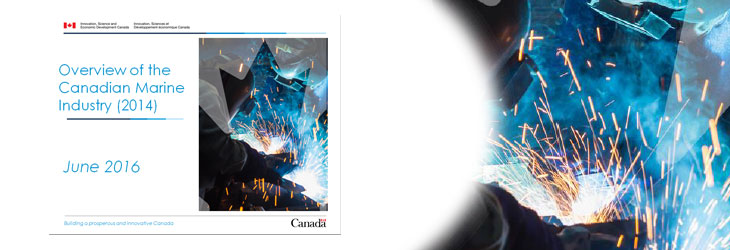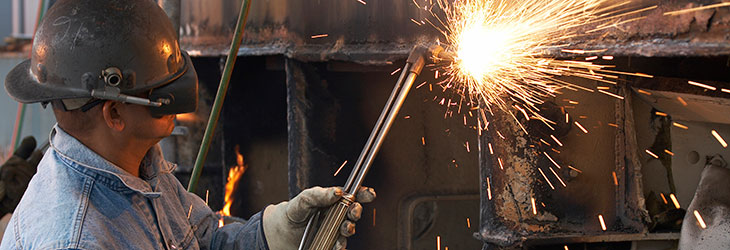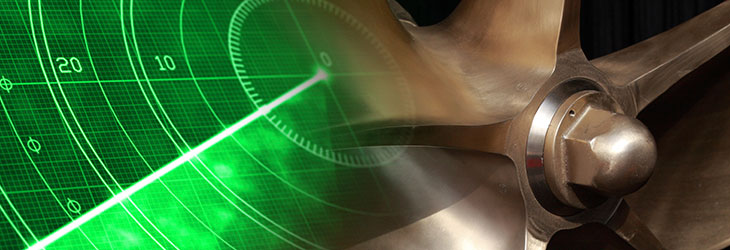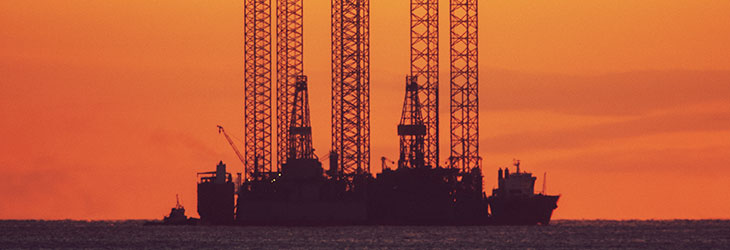
Canada’s offshore oil and gas sector provides a source for marine manufacturing activity. Activities include the design, engineering and production of structures, equipment, modules and the provision of services (i.e. repair and maintenance of platforms, outfitting and conversion of vessels) that supports the offshore oil and gas industry.
Similar to shipbuilding, the industry is characterized by ‘boom and bust’ cycles dependant on various factors including demand and the price of oil. Activities generally increase when new or extensions of offshore projects are in development or when the replacement of equipment is required. There is however a relatively constant activity for the maintenance and repair of supply vessels and platforms.
The offshore oil and gas structures and components sector’s sales totaled $236.8M accounting for 13.5% of total marine sales in 2014.
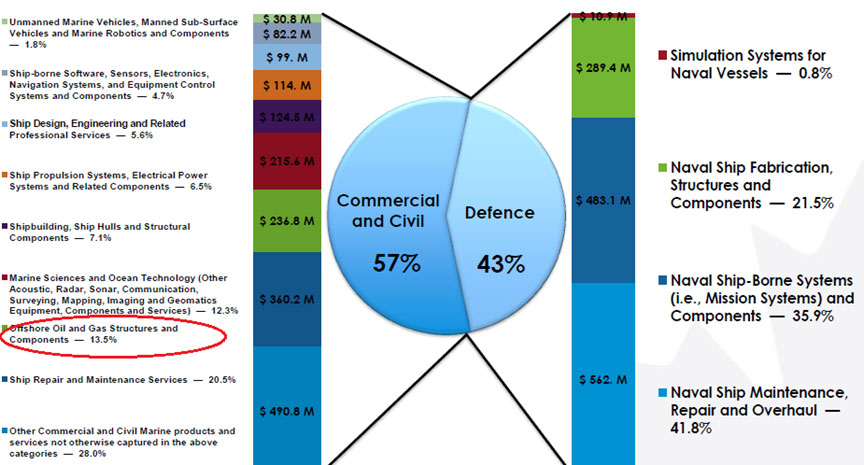
Major projects:
Atlantic Canada’s offshore oil and gas industry is comprised of five producing projects, one development project, and other ongoing exploration activity. Find out more about the production and development projects offshore:
Newfoundland & Labrador
- Hebron (production anticipated for 2017)
Nova Scotia
- Sable Offshore Energy Project
- Deep Panuke Natural Gas Project
- Through the Cohasset-Panuke Project, Nova Scotia was home to Canada’s first offshore oil project in 1992.
Highlights of Canadian Capabilities (structures, equipment and services)
Offshore platforms components, offshore rig components, topsides modules, module outfitting, support & anchor handling tugs, platform supply vessels, metal fabrication and pipe work for offshore platforms.
- Expertise and innovative technologies related to the offshore oil and gas industry such as ice management, remote sensing, operations in harsh environments, health and safety, oil spill responses.
- Repair, maintenance and outfitting services for vessels and platforms.
Government Support and Initiatives
Visit our programs and initiatives page to find out more about programs that can help you support your business.
Legislation and Regulations of the Offshore Oil and Gas Industry
Accord Acts: The Canada-Newfoundland Atlantic Accord Implementation Act and the Canada-Nova Scotia Offshore Petroleum Resources Accord Implementation Act, known as the Accord Acts, implement agreements between the federal and provincial governments relating to offshore oil and gas resources. The Accord Acts outline the shared management of oil and gas resources in the offshore, revenue sharing, and establishes the respective offshore regulatory boards.
Industrial Benefits: The Accord Acts require that, before any work or activity is authorized in the offshore area, a Benefits Plan must be approved by the Canada-Newfoundland Offshore Petroleum Board or the Canada-Nova Scotia Offshore Petroleum Board. A benefits plan must describe a plan for the employment of Canadians and, in particular, workers within the province; and for providing manufacturers, consultants, contractors, and service companies in the province and other parts of Canada with a full and fair opportunity to participate in the supply of goods and services on a competitive basis.
In the Canadian north, Canada’s oil and gas industry is regulated by the Minister of Indigenous and Northern Affairs Canada and the National Energy Board. Elsewhere in the country, the Canada Petroleum Resources Act (CPRA) and the Canada Oil and Gas Operations Act (COGOA) govern offshore and frontier oil and gas activities.
Visit the Natural Resources Canada website for more information about the principal Acts governing offshore oil and gas activities.
Other Resources
- National Energy Board: Has regulatory responsibilities for oil and gas exploration and activities on frontier lands not otherwise regulated under joint federal/provincial accords.
- Indigenous and Northern Affairs Canada: Works in partnership with Northern and Indigenous governments and peoples to govern the allocation of Crown lands to the private sector for oil and gas exploration, develop the regulatory environment, set and collect royalties and approve benefit plans before development takes place in a given area
- Canada-Newfoundland Offshore Petroleum Board: The Canada-Newfoundland and Labrador Offshore Petroleum Board (C-NLOPB ) manages the petroleum resources in the Newfoundland Offshore Area on behalf of the Government of Canada and the Government of Newfoundland and Labrador.
- Canada-Nova Scotia Offshore Petroleum Board: The Canada-Nova Scotia Offshore Petroleum Board (CNSOPB) is the independent joint agency of the Governments of Canada and Nova Scotia responsible for the regulation of petroleum activities in the Nova Scotia Offshore Area.


